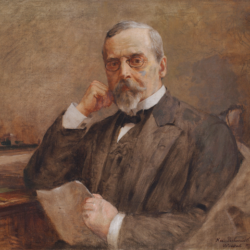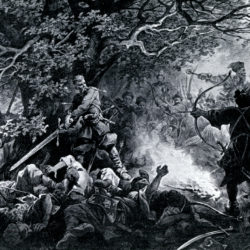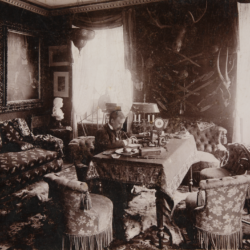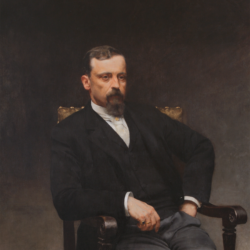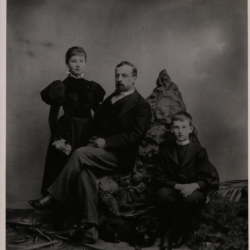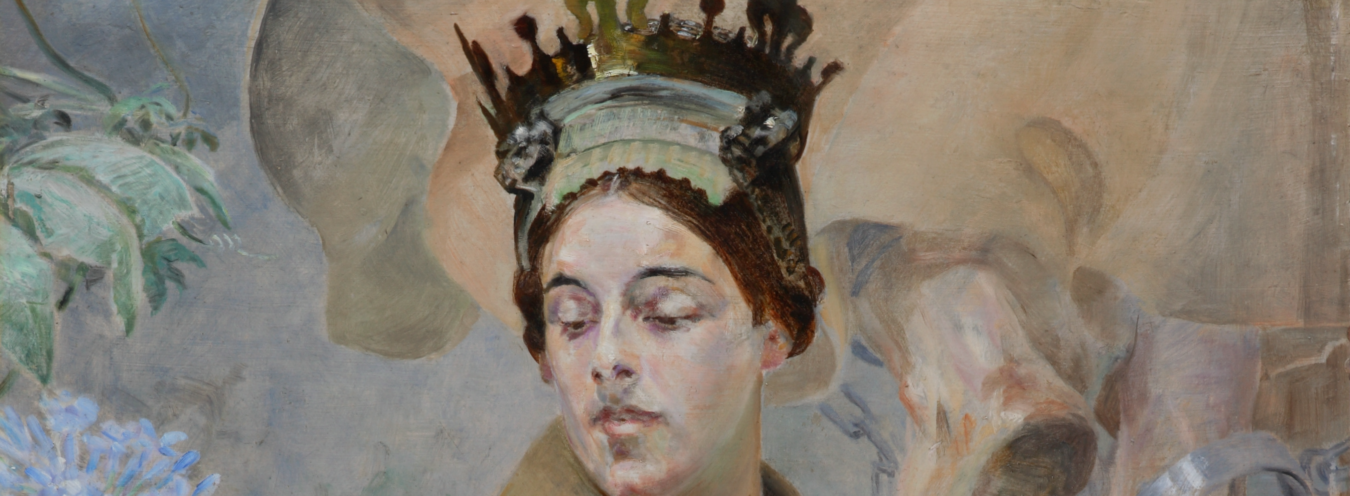
Living Pictures II
Apotheosis was one of the most popular subgenres of tableaux vivants. In this context, it is important to mention Wojciech Gerson, a famous artist, co-founder of the Zachęta Fine Arts Fellowship, under whose tutorship Jadwiga Janczewska painted her famous self-portrait.[1] Wojciech Gerson was an experienced creator of tableaux vivants[2] and the father of Maria Gerson-Dąbrowska. I quote Gerson-Dąbrowska’s work here as since early childhood she was acquainted with the rules of staging painted works. Her manual for the staging of tableaux vivants which I quote in my paper was created at the time when “living pictures” were losing their popularity. Gerson-Dąbrowska introduced early 20th-century readers to the rules of such performances, revealing the invisible backstage to the spectators. For a contemporary reader, however, Gerson-Dąbrowska presents the world of an art almost forgotten, as we could only know the performances from their descriptions in the press, and rarely from photographs.
The key to a successful performance was the proper “composition of the image,” aiming at a clear reception. An adequately large team of actors holding items of symbolic value should be grouped together. The scene should be properly lit in order to bring out the vividness of colors. The compositional success depended on the right choice of background as well. Gerson-Dąbrowska stated:
Paintings aiming at a certain form of apotheosis, i.e. awarding special merits to someone (for example, Kościuszko, Jagiełło, Piast, Poland, or Education personified), require a symmetrical grouping. Sometimes, instead of placing a live person, a portrait, a bust, or a statue can be placed in the center, and live people may surround it. This formula is popular when someone with accomplishments for the country, art, or science is celebrated.[3]
These general tips precede the manual for paying homage to artists:
If we stage an apotheosis of a poet or an artist – such as, for example, Mickiewicz, Grottger, Matejko, or Sienkiewicz – characters stemming from his works may surround his bust or portrait. […] Therefore, Sienkiewicz could be accompanied by Skrzetuski (Skshetuski), Wołodyjowski (Volodyovski), Kmicic (Kmita), Oleńka, Zagłoba, etc.[4]
Małgorzata Komza, an author of a contemporary monograph devoted to tableaux vivants, pinpoints that this particular kind of art is hard to define: the rules for staging tableaux changed over the decades, and the characteristics of a genre could be distinguished only since the end of the 18th century. The positioning of the actors on the stage was crucial but also the fact that this was a silent and, at least partially, a static performance. Sometimes it had a dramaturgy of its own and consisted of a sequence of representations divided by the closing of a curtain. Sometimes the forming of the final tableau was preceded by a peculiar pantomime: actors assuming their positions on the stage. In other circumstances, mobile lighting was used, as well as color-changing lights. Some performances were accompanied by live music.[5] Tableaux vivants are something in which the spectators participate, something which they perceive and interpret, but do not discuss in detail. Even press accounts consist of either enthusiastic reviews (“a highly aesthetical spectacle”) or descriptions devoid of elements of critical analysis. The comprehension of the performance’s reception was meant to be instantaneous and communal. By definition, a critic had no access to its meaning and was left “deeply thrilled.” What we are left with is, therefore, an archeology of affects.
The spectacles had specific topics: scenes from everyday life, allegories, or a mixture of both. The tableau from Stanisławów was an example of such a mixture, combining the story of a particular man and his work with the symbolic representation of Polishness. Dariusz Kosiński, when writing about Polish cultural spectacles, argues that “Polish culture, or even Polish identity, has had a deeply theatrical character. It is proven by the manner in which events and practices existed: the way in which historical events have been played out, how political and religious practices have functioned, and how different and important Polish spectacles have always been.” Kosiński makes this argument in order to “emphasize the crucial values of the theatrical manner of life, which contributed to the survival of a community – together with the values that were considered by this community as the most important.”[6]
These two sentences by Kosiński ought to be quoted every time a scholar is exposed to the source materials describing the oddness of communal life of 19th-century Poles in the so-called Vistula Land and in other Polish lands stripped of their autonomy by the Russian Empire. I remind myself of Kosiński’s words whenever I read the emotion-laden descriptions of the ecstatic collective reactions to speeches given by Henryk Sienkiewicz and other idols of that time. These two sentences resonate in my mind whenever I come across accounts of euphoric greetings in the streets, the homage paid to Sienkiewicz both in provincial committees and by the members of metropolitan high society. Kosiński’s phrase “the manner in which events and practices existed” suggests that this was a “manner” which was to certain extent atypical: the events did not “simply” happen, and the cultural practices did not find their “regular realizations,” to which special attention need not have been given. Quite the contrary – just like plants taking root in atypical conditions – the events had strangely distorted shapes, a confusing “manner of existence.” That is why the Aesopian language full of metaphors and substitutes was used by Poles living after the January Rising in three countries-provinces which used to be united, but which one did not even know how to properly call after the partitions. These Poles were combining different themes, which is why it is nowadays difficult to disentangle the strands of a tight knot of their imagery. This penchant for complexity may be the reason behind the immense popularity of the silent tableaux vivants in the territories in question, as the formation of Polish public life was not allowed in the territories lacking autonomy. This is why noticing in the “manner of existence” a manifestation of “mass,”[7] and not “public” life, importantly points to the fact that the Poles were sending a subversive, hidden message through performative acts and practices. Sienkiewicz himself was a master of hints, parables, metaphors, and palimpsests. Consequently, he often became a part of an intricate universe of signs and indirect references, as, for example, during the Warsaw jubilee or in the tableau performed in Stanisławów. The live nature of these events, however, is difficult to analyze today, as only the textual accounts are left.
According to a theatrical interpretation of the performance in Stanisławów, Sienkiewicz and his literary protagonists stemming from different times (the era of Sarmatianism in Poland, the birth of Christianity) and places (the Polish-Lithuanian Commonwealth, ancient Rome) are paying homage to the writer and the inexistent – though victorious – Poland. This consolidates the set of values distributed among the members of the Polish nation. We can, however, broaden this interpretation – if the apotheosis in question, as well as the lesser-known one held in Warsaw,[8] are treated as a cultural performance in line with the performative approach suggested by Kosiński. In such a case, we could say that Polish victory and glory were becoming more real with each time the curtain opened, and with each glance shot at Sienkiewicz’s bust exhibited in one of the formally non-Polish – but otherwise very Polish – cities. We could say that this performance not only reminded about the available definition of Polishness (Sarmatian, Catholic, resurrected – as the props would suggest), but it could create anew the idea of what Polishness means. These two functions – recreation and creation – can be found in the classic definitions of cultural performances, such as the one formulated by John MacAloon. According to him, performances are the peculiar “occasions in which as a […] society we reflect upon and define ourselves, dramatize our collective myths and history, present ourselves with alternatives, and eventually change in some ways while remaining the same in other.”[9] It is important to note that I am discussing the art of tableau vivant which was at that time already anachronistic.
Looking for other “Polish meta-images” of the second half of the 19th century, the scholars have been focusing on representations subject to reproduction: Iwona Kurz discussed Pięciu poległych (Five men down) by Karol Beyer (by no means a tableau vivant),[10] and Łukasz Zaręba focused on Artur Grottger’s cycle devoted to the January Rising.[11] In the case of the performance I analyze, its anonymous authors create something unique, to be seen live and only once. The characters constituting the apotheosis of Sienkiewicz and the Polish community were lit by the glittering of fireworks, and thus revealed themselves to the audience in Stanisławów for only a moment. They were visible for a few dozen seconds as if the flash of a camera went off, but at the same time, they were presented in multiple encores, as if a series of photographs was taken. Such a short-lived unveiling was not a generic characteristic of tableaux vivants but rather their popular subgenre.[12] Put briefly, the spectators were participating in a performance invoking and updating the mythical past of a Catholic country, the spectacle of which, at the same time, aimed at defining Polishness for future generations. Mythology and modernity formed a double loop in a combination of the old-fashioned practice of tableaux vivants with a reference to flash photography: this appears to be a format perfectly suited for celebrating Henryk Sienkiewicz’s jubilee.
Przypisy
- J. Janczewska, Autoportret [Self-portrait]:http://mnki.pl/pl/obiekt_tygodnia/2017/pokaz/231,jadwiga_janczewska__autoportret [Accessed on: 25.09.2018].
- M. Komza, Żywe obrazy. Między sceną, obrazem i książką [Tableaux Vivants: The scene, the image, and the book], Wyd. Uniwersytetu Wrocławskiego, Wrocław 1995, pp. 106–8.
- Op. cit., pp. 8–9; trans. K. F.
- Op. cit., p. 9; trans. K. F.
- M. Komza, op.cit., pp. 124–38.
- D. Kosiński, Teatra polskie. Historie [Polish theaters: Histories], Wyd. Naukowe PWN, Instytut Teatralny im. Zbigniewa Raszewskiego, Warsaw 2010, p. 21; trans. K. F.
- A. Mencwel, Stanisław Brzozowski. Postawa krytyczna. Wiek XX [Stanisław Brzozowski: A critical attitude. The 20th century], Wyd. Krytyki Politycznej, Warsaw 2014, pp. 79–82; trans. K. F.
- A brief mention appears in Karolina Beylin’s memoirs, see W Warszawie w latach 1900–1914 [In Warsaw, between 1900 and 1914], PIW, Warsaw 1972, p. 35.
- J. J. MacAloon, “Introduction: Cultural Performance, Cultural Theory,” in Rite, Drama, Festival, Spectacle: Rehearsals Toward a Theory of Cultural Performance, edited by John J. MacAloon, 1984, p. i; emphasis added.
- I. Kurz, “‘Pięciu poległych’ jako metaobraz kultury polskiej połowy XIX wieku” [“Five Men Down”: A metaimage of Polish culture in the mid-19th century], Widok. Teorie i Praktyki Kultury Wizualnej 2015, vol. 10; http://pismowidok.org/index.php/one/article/view/312/590 [Accessed on: 25.09.2018].
- Ł. Zaremba, “Obraz” [Image], in Kultura wizualna w Polsce. Spojrzenia [Visual culture in Poland], edited by I. Kurz et al., Warsaw 2017 (see especially the subchapter entitled Imagines Polonices, pp. 89–93).
- M. Komza, op. cit., p. 136.

